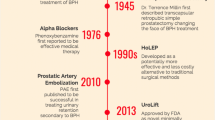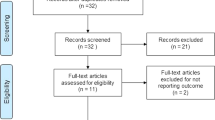Abstract
Purpose
Ejaculatory dysfunction is the most common side effect related to surgical treatment of benign prostatic obstruction (BPO). Nowadays, modified surgical techniques and non-ablative techniques have emerged with the aim of preserving antegrade ejaculation. Our objective was to conduce a systematic review of the literature regarding efficacy on ejaculatory preservation of modified endoscopic surgical techniques, and mini-invasive non-ablatives techniques for BPO management.
Methods
A systematic review of the literature was carried out on the PubMed database using the following MESH terms: “Prostatic Hyperplasia/surgery” and “Ejaculation”, in combination with the following keywords: “ejaculation preservation”, “photoselective vaporization of the prostate”, “photoselective vapo-enucleation of the prostate”, “holmium laser enucleation of the prostate”, “thulium laser”, “prostatic artery embolization”, “urolift”, “rezum”, and “aquablation”.
Results
The ejaculation preservation rate of modified-TURP ranged from 66 to 91%. The ejaculation preservation rate of modified-prostate photo-vaporization ranged from 87 to 96%. The only high level of evidence studies available compared prostatic urethral lift (PUL) and aquablation versus regular TURP in prospective randomized-controlled trials. The ejaculation preservation rate of either PUL or aquablation compared to regular TURP was 100 and 90 versus 34%, respectively.
Conclusions
Non-ablative therapies and modified endoscopic surgical techniques seemed to be reasonable options for patients eager to preserve their ejaculatory functions.

Similar content being viewed by others
References
Marra G, Sturch P, Oderda M et al (2016) Systematic review of lower urinary tract symptoms/benign prostatic hyperplasia surgical treatments on men’s ejaculatory function: time for a bespoke approach? Int J Urol Off J Jpn Urol Assoc 23:22–35. https://doi.org/10.1111/iju.12866
Descazeaud A, Robert G, Delongchamps NB et al (2012) Initial assessment, follow-up and treatment of lower urinary tract symptoms related to benign prostatic hyperplasia: guidelines of the LUTS committee of the French Urological Association. Prog En Urol J Assoc Fr Urol Société Fr Urol 22:977–988. https://doi.org/10.1016/j.purol.2012.10.001
Gratzke C, Bachmann A, Descazeaud A et al (2015) EAU guidelines on the assessment of non-neurogenic male lower urinary tract symptoms including benign prostatic obstruction. Eur Urol 67:1099–1109. https://doi.org/10.1016/j.eururo.2014.12.038
Madersbacher S, Marberger M (1999) Is transurethral resection of the prostate still justified? BJU Int 83:227–237
Ronzoni G, De Vecchis M (1998) Preservation of anterograde ejaculation after transurethral resection of both the prostate and bladder neck. Br J Urol 81:830–833
Alloussi SH, Lang C, Eichel R, Alloussi S (2014) Ejaculation-preserving transurethral resection of prostate and bladder neck: short- and long-term results of a new innovative resection technique. J Endourol Endourol Soc 28:84–89. https://doi.org/10.1089/end.2013.0093
Talab SS, Santiago-Lastra YA, Bachmann A et al (2013) V403 the impact of ejaculation-preserving photo-selective vaporization of the prostate (EP-PVP) on lower urinary tract symptoms and ejaculatory function: results of a multicenter study. J Urol 189:e164. https://doi.org/10.1016/j.juro.2013.02.1792
Kim M, Song SH, Ku JH et al (2015) Pilot study of the clinical efficacy of ejaculatory hood sparing technique for ejaculation preservation in holmium laser enucleation of the prostate. Int J Impot Res 27:20–24. https://doi.org/10.1038/ijir.2014.22
Roehrborn CG, Barkin J, Gange SN et al (2017) Five year results of the prospective randomized controlled prostatic urethral L.I.F.T. study. Can J Urol 24:8802–8813
Gratzke C, Barber N, Speakman MJ et al (2017) Prostatic urethral lift vs transurethral resection of the prostate: 2-year results of the BPH6 prospective, multicentre, randomized study. BJU Int 119:767–775. https://doi.org/10.1111/bju.13714
Pisco J, Bilhim T, Pinheiro LC et al (2016) Prostate embolization as an alternative to open surgery in patients with large prostate and moderate to severe lower urinary tract symptoms. J Vasc Interv Radiol JVIR 27:700–708. https://doi.org/10.1016/j.jvir.2016.01.138
Mynderse LA, Hanson D, Robb RA et al (2015) Rezūm system water vapor treatment for lower urinary tract symptoms/benign prostatic hyperplasia: validation of convective thermal energy transfer and characterization with magnetic resonance imaging and 3-dimensional renderings. Urology 86:122–127. https://doi.org/10.1016/j.urology.2015.03.021
Durieux N, Vandenput S, Pasleau F (2013) OCEBM levels of evidence system. Rev Médicale Liège 68:644–649
Brookes ST, Donovan JL, Peters TJ et al (2002) Sexual dysfunction in men after treatment for lower urinary tract symptoms: evidence from randomised controlled trial. BMJ 324:1059–1061
Chen Q, Zhang L, Fan Q-L et al (2010) Bipolar transurethral resection in saline vs traditional monopolar resection of the prostate: results of a randomized trial with a 2-year follow-up. BJU Int 106:1339–1343. https://doi.org/10.1111/j.1464-410X.2010.09401.x
Møller-Nielsen C, Lundhus E, Møller-Madsen B et al (1985) Sexual life following “minimal” and “total” transurethral prostatic resection. Urol Int 40:3–4
Ahyai SA, Lehrich K, Kuntz RM (2007) Holmium laser enucleation versus transurethral resection of the prostate: 3-year follow-up results of a randomized clinical trial. Eur Urol 52:1456–1463. https://doi.org/10.1016/j.eururo.2007.04.053
Kuntz RM, Ahyai S, Lehrich K, Fayad A (2004) Transurethral holmium laser enucleation of the prostate versus transurethral electrocautery resection of the prostate: a randomized prospective trial in 200 patients. J Urol 172:1012–1016. https://doi.org/10.1097/01.ju.0000136218.11998.9e
Placer J, Salvador C, Planas J et al (2015) Effects of holmium laser enucleation of the prostate on sexual function. J Endourol 29:332–339. https://doi.org/10.1089/end.2014.0502
Thomas JA, Tubaro A, Barber N et al (2016) A multicenter randomized noninferiority trial comparing GreenLight-XPS laser vaporization of the prostate and transurethral resection of the prostate for the treatment of benign prostatic obstruction: two-yr outcomes of the GOLIATH study. Eur Urol 69:94–102. https://doi.org/10.1016/j.eururo.2015.07.054
Yee CLS, Pal RP, Batchelder A, Khan MA (2012) Risk of erectile dysfunction and retrograde ejaculation associated with thulium laser vaporesection of the prostate for bladder outflow obstruction: a retrospective study. Urol Int 88:165–169. https://doi.org/10.1159/000333046
Xia S-J, Zhuo J, Sun X-W et al (2008) Thulium laser versus standard transurethral resection of the prostate: a randomized prospective trial. Eur Urol 53:382–389. https://doi.org/10.1016/j.eururo.2007.05.019
Yang Q, Peters TJ, Donovan JL et al (2001) Transurethral incision compared with transurethral resection of the prostate for bladder outlet obstruction: a systematic review and meta-analysis of randomized controlled trials. J Urol 165:1526–1532
Lourenco T, Shaw M, Fraser C et al (2010) The clinical effectiveness of transurethral incision of the prostate: a systematic review of randomised controlled trials. World J Urol 28:23–32. https://doi.org/10.1007/s00345-009-0496-8
Reich O, Gratzke C, Stief CG (2006) Techniques and long-term results of surgical procedures for BPH. Eur Urol 49:970–978. https://doi.org/10.1016/j.eururo.2005.12.072
Oelke M, Bachmann A, Descazeaud A et al (2013) EAU guidelines on the treatment and follow-up of non-neurogenic male lower urinary tract symptoms including benign prostatic obstruction. Eur Urol 64:118–140. https://doi.org/10.1016/j.eururo.2013.03.004
Rynja S, Bosch R, Kok E et al (2010) IIEF-15: unsuitable for assessing erectile function of young men? J Sex Med 7:2825–2830. https://doi.org/10.1111/j.1743-6109.2010.01847.x
Rosen RC, Catania JA, Althof SE et al (2007) Development and validation of four-item version of Male Sexual Health Questionnaire to assess ejaculatory dysfunction. Urology 69:805–809. https://doi.org/10.1016/j.urology.2007.02.036
Rosen R, Altwein J, Boyle P et al (2003) Lower urinary tract symptoms and male sexual dysfunction: the multinational survey of the aging male (MSAM-7). Eur Urol 44:637–649
Feldman HA, Goldstein I, Hatzichristou DG et al (1994) Impotence and its medical and psychosocial correlates: results of the Massachusetts Male Aging Study. J Urol 151:54–61
Kim JK, Cho MC, Son H et al (2017) Patient perception of ejaculatory volume reduction after holmium laser enucleation of the prostate (HoLEP). Urology 99:142–147. https://doi.org/10.1016/j.urology.2016.09.037
Elshal AM, El-Assmy A, Mekkawy R et al (2017) Prospective controlled assessment of men’s sexual function changes following holmium laser enucleation of the prostate for treatment of benign prostate hyperplasia. Int Urol Nephrol 49:1741–1749. https://doi.org/10.1007/s11255-017-1649-0
Hedlund H, Ek A (1985) Ejaculation and sexual function after endoscopic bladder neck incision. Br J Urol 57:164–167
Yang SS-D, Tsai Y-C, Chen J-J et al (2008) Modified transurethral incision of the bladder neck treating primary bladder neck obstruction in young men: a method to improve voiding function and to preserve antegrade ejaculation. Urol Int 80:26–30. https://doi.org/10.1159/000111725
Gil-Vernet JM, Alvarez-Vijande R, Gil-Vernet A, Gil-Vernet JM (1994) Ejaculation in men: a dynamic endorectal ultrasonographical study. Br J Urol 73:442–448
Sturch P, Woo HH, McNicholas T, Muir G (2015) Ejaculatory dysfunction after treatment for lower urinary tract symptoms: retrograde ejaculation or retrograde thinking? BJU Int 115:186–187. https://doi.org/10.1111/bju.12868
Ben Rhouma S, Ben Chehida MA, Ahmed S et al (2016) MP42-18 can we preserve ejaculation after transurethral resection of the prostate? Comparative study between the conventional technique and a new technique about 70 cases. J Urol 195:e577. https://doi.org/10.1016/j.juro.2016.02.206
Leonardi R (2009) Preliminary results on selective light vaporization with the side-firing 980 nm diode laser in benign prostatic hyperplasia: an ejaculation sparing technique. Prostate Cancer Prostatic Dis 12:277–280. https://doi.org/10.1038/pcan.2009.5
Miyauchi T, Yusu H, Kanzaki M (2016) V3-06 ejaculation-sparing photoselective vaporization of the prostate: evaluation of the ejaculatory function and the lower urinary tract symptoms. J Urol 195:e468. https://doi.org/10.1016/j.juro.2016.02.1526
Roehrborn CG, Rukstalis DB, Barkin J et al (2015) Three year results of the prostatic urethral L.I.F.T. study. Can J Urol 22:7772–7782
Carnevale FC, Iscaife A, Yoshinaga EM et al (2016) Transurethral resection of the prostate (TURP) versus original and PErFecTED prostate artery embolization (PAE) due to benign prostatic hyperplasia (BPH): preliminary results of a single center, prospective, urodynamic-controlled analysis. Cardiovasc Interv Radiol 39:44–52. https://doi.org/10.1007/s00270-015-1202-4
Gao Y, Huang Y, Zhang R et al (2014) Benign prostatic hyperplasia: prostatic arterial embolization versus transurethral resection of the prostate—a prospective, randomized, and controlled clinical trial. Radiology 270:920–928. https://doi.org/10.1148/radiol.13122803
Amouyal G, Thiounn N, Pellerin O et al (2016) Clinical results after prostatic artery embolization using the PErFecTED technique: a single-center study. Cardiovasc Interv Radiol 39:367–375. https://doi.org/10.1007/s00270-015-1267-0
Kuang M, Vu A, Athreya S (2017) A systematic review of prostatic artery embolization in the treatment of symptomatic benign prostatic hyperplasia. Cardiovasc Interv Radiol 40:655–663. https://doi.org/10.1007/s00270-016-1539-3
Roehrborn CG, Gange SN, Gittelman MC et al (2017) Convective thermal therapy: durable 2-year results of randomized controlled and prospective crossover studies for treatment of lower urinary tract symptoms due to benign prostatic hyperplasia. J Urol 197:1507–1516. https://doi.org/10.1016/j.juro.2016.12.045
McVary KT, Roehrborn CG (2017) Three-year outcomes of the prospective, randomized controlled Rezūm system study: convective radiofrequency thermal therapy for treatment of lower urinary tract symptoms due to benign prostatic hyperplasia. Urology. https://doi.org/10.1016/j.urology.2017.10.023
Dixon C, Cedano ER, Pacik D et al (2015) Efficacy and safety of Rezūm system water vapor treatment for lower urinary tract symptoms secondary to benign prostatic hyperplasia. Urology 86:1042–1047. https://doi.org/10.1016/j.urology.2015.05.046
Gilling P, Anderson P, Tan A (2017) Aquablation of the prostate for symptomatic benign prostatic hyperplasia: 1-year results. J Urol 197:1565–1572. https://doi.org/10.1016/j.juro.2017.01.056
Gilling P, Reuther R, Kahokehr A, Fraundorfer M (2016) Aquablation—image-guided robot-assisted waterjet ablation of the prostate: initial clinical experience. BJU Int 117:923–929. https://doi.org/10.1111/bju.13358
Gilling P, Barber N, Bidair M et al (2018) WATER—a double-blind randomized controlled trial of Aquablation vs. transurethral resection of the prostate in benign prostatic hyperplasia. J Urol. https://doi.org/10.1016/j.juro.2017.12.065
Author information
Authors and Affiliations
Consortia
Contributions
SL: project development, data collection, and manuscript writing. AC: project development, data collection, and manuscript writing. NBD, AB, JNC, AD, SD, MF, BP, VM, GR, and PET: project development and reviewing.
Corresponding author
Ethics declarations
Conflict of interest
Armand Chevrot: none. Nicolas Barry Delongchamps: none. Amin Benchikh: none. Jean Nicolas Cornu: none. Aurélien Descazeaud: consultant for Bouchara Recordati, Pierre Fabre Medicament, Lilly, investigator pour EDAP TMS. Steeve Doizi: none. Marc Fourmarier: consultant for GSK and EDAP TMS. Souhil Lebdai: none. Benjamin Pradère: none. Vincent Misraï: none. Gregoire Robert: consultant for Pierre Fabre Medicament, investigator for EDAP TMS. Pierre Etienne Theveniaud: none.
Research involving human participants and/or animals
Not applicable.
Informed consent
Not applicable.
Rights and permissions
About this article
Cite this article
Lebdai, S., Chevrot, A., Doizi, S. et al. Do patients have to choose between ejaculation and miction? A systematic review about ejaculation preservation technics for benign prostatic obstruction surgical treatment. World J Urol 37, 299–308 (2019). https://doi.org/10.1007/s00345-018-2368-6
Received:
Accepted:
Published:
Issue Date:
DOI: https://doi.org/10.1007/s00345-018-2368-6




